History
Construction and opening
Kilmarnock Infirmary opened in 1868 in Wellington Street, to meet the needs of the growing population in Kilmarnock. The original building was designed by the prolific Kilmarnock architect, William Atkinson Railton. [2] The foundation stone was laid in September 1867 and the building opened in October 1868. [3] A children's block and a nurses' training school were added in 1891. In 1923 it had a capacity of 130 beds. [4]
Expansion
Built on land used by neighbouring Mount Pleasant House, following the opening of the Kilmarnock Infirmary, Mount Pleasant House began to be used for administrative duties and functions of the hospital, but was later demolished in order to clear land to allow for the new construction of additional wings to the main hospital building. [1] A children's ward was added to the Kilmarnock Infirmary in 1891, totalling £4,100 to construct. The vast majority of the money used to construct the children's ward was donated to the project by Dowager Lady Howard de Walden. Additions to the ward occurred in 1893, followed by the creation of a new fevers block in 1899. [1]
A further additional wards, as well as new dining rooms, kitchen, mortuary and administration block were opened at the hospital on 19 May 1923 by a Miss Finnie, after plans had to be postponed due to the outbreak of World War I. The 1923 expansion project was designed by Sir John Burrnett who had sought the advice and experience of Dr Mackintosh at the Western Infirmary in Glasgow, and used the information he had gained from their discussion to create his plans for the 1923 expansion. Following the expansion, the hospitals total bed capacity had increased to 130 beds being available for patients. Further expansions in the 1930s included the addition of a new recreation hall and lecture theatre. [1]
Closure
After a new clock was completed in 1921, the original building became the nurses' home. Kilmarnock Infirmary was seen as a hospital which had become largely constrained by its small and prominent town centre location, and discussions began to commence to merge Kilmarnock Infirmary with Ayr County Hospital in a new building located on Grassyards Road in Kilmarnock. Plans eventually fell through, and the proposals were eventually abandoned due to the outbreak of World War II. [1]
After services transferred to Crosshouse Hospital, Kilmarnock Infirmary closed in 1982. [5] Following a period of remaining vacant due to refusal to demolish the infirmary building, it was eventually demolished together with the accident and emergency building in the late 1980s. Demolition occurred, despite there being plans to turn the site and building into a nursing home, but these proposals were not granted permission. The listed nurses' home building was demolished under a Dangerous Building Notice in September 1997, following the building suffering severe damage after a fire in 1994. [1] [6]
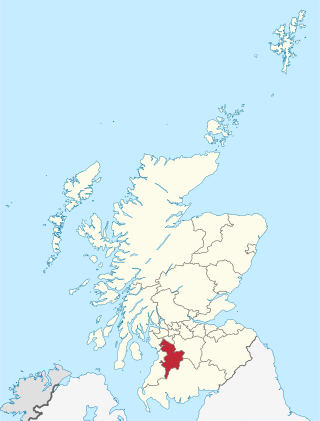
East Ayrshire is one of 32 unitary council areas of Scotland. It shares borders with Dumfries and Galloway, East Renfrewshire, North Ayrshire, South Ayrshire and South Lanarkshire. The headquarters of the council are located on London Road, Kilmarnock. With South Ayrshire and the mainland areas of North Ayrshire, it formed the former county of Ayrshire.

Kilmarnock is a town and former burgh in East Ayrshire situated in southwest Scotland. The town has served as the administrative centre of East Ayrshire Council since 1996 and is the regions main commercial and industrial centre.

The Western General Hospital is a health facility at Craigleith, Edinburgh, Scotland. It is managed by NHS Lothian.
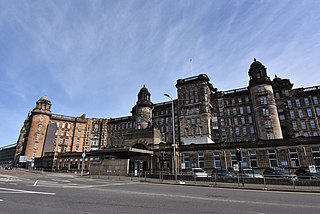
The Glasgow Royal Infirmary (GRI) is a large teaching hospital. With a capacity of around 1,000 beds, the hospital campus covers an area of around 8 hectares, and straddles the Townhead and Dennistoun districts on the north-eastern fringe of the city centre of Glasgow, Scotland. It is managed by NHS Greater Glasgow and Clyde. It was originally opened in 1794, with the present main building dating from 1914.

The Royal Infirmary of Edinburgh (RIE), often known as the Edinburgh Royal Infirmary (ERI), was established in 1729 and is the oldest voluntary hospital in Scotland. The new buildings of 1879 were claimed to be the largest voluntary hospital in the United Kingdom, and later on, the Empire. The hospital moved to a new 900 bed site in 2003 in Little France. It is the site of clinical medicine teaching as well as a teaching hospital for the University of Edinburgh Medical School. In 1960, the first successful kidney transplant performed in the UK was at this hospital. In 1964, the world's first coronary care unit was established at the hospital. It is the only site for liver, pancreas and pancreatic islet cell transplantation and one of two sites for kidney transplantation in Scotland. In 2012, the Emergency Department had 113,000 patient attendances, the highest number in Scotland. It is managed by NHS Lothian.

Stobhill Hospital is located in Springburn in the north of Glasgow, Scotland. It serves the population of North Glasgow and part of East Dunbartonshire. It is managed by NHS Greater Glasgow and Clyde.

NHS Ayrshire and Arran is one of the fourteen regions of NHS Scotland. It was formed on 1 April 2004.
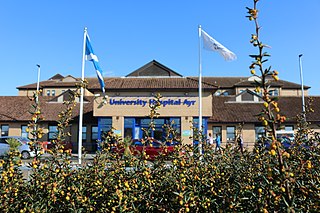
University Hospital Ayr is a general hospital on the outskirts of Ayr, Scotland. It covers a catchment area of approximately 100,000 people in South Ayrshire and is managed by NHS Ayrshire and Arran.

University Hospital Crosshouse, known locally as Crosshouse Hospital, is a large district general hospital situated outside the village of Crosshouse, two miles outside Kilmarnock town centre in Scotland. It provides services to the North Ayrshire and East Ayrshire areas and is managed by NHS Ayrshire and Arran.

Bonnyton is a former village, currently an area in the western part of Kilmarnock in East Ayrshire, Scotland. It is home to a mix of residential and commercial properties, centred around estates such as Bonnyton Road, Munro Avenue and Gibson Street.

Crosshouse is a village in East Ayrshire about 3 kilometres west of Kilmarnock. It grew around the cross-roads of the main Kilmarnock to Irvine road, once classified as the A71 but now reduced in status to the B7081, with a secondary road running from Kilmaurs south to Gatehead and beyond towards Prestwick. The Carmel Water, a tributary of the River Irvine, flows through the centre of the village. It had an estimated population of 2,690 in 2020

Ayrshire Central Hospital, also known as Irvine Central Hospital, is an NHS hospital in Irvine, North Ayrshire, Scotland. It is managed by NHS Ayrshire and Arran.
Kirklandside was a community hospital in the village of Hurlford a few miles out of Kilmarnock, Scotland. It was managed by NHS Ayrshire and Arran.
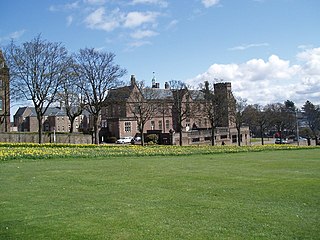
Dundee Royal Infirmary, often shortened to DRI, was a major teaching hospital in Dundee, Scotland. Until the opening of Ninewells Hospital in 1974, Dundee Royal Infirmary was Dundee's main hospital. It was closed in 1998, after 200 years of operation.
St James' Hospital was a healthcare facility in Balham, London that existed between 1910 and 1988. The hospital buildings occupied sites within the boundary of Ouseley Road, Sarsfield Road and St James's Drive Balham London SW12.

Ailsa Hospital is a mental health facility located in the southeastern outskirts of Ayr, South Ayrshire, Scotland. It is managed by NHS Ayrshire and Arran.

Woodland View is an acute mental health hospital, acute adult services and elderly and community rehabilitation facility located within the grounds of Ayrshire Central Hospital, Irvine, North Ayrshire, Scotland. The hospital was constructed by Balfour Beattie Construction, and opened in 2016.

On 4 February 2021, three separate fatal incidents occurred in Kilmarnock, Scotland. The incidents were thought to be linked and involved the same 40-year-old man, Steven Robertson. In the first incident, a woman died after being injured outside University Hospital Crosshouse. In the second incident, a woman died after being stabbed in the town. In the third incident, the man was killed in a road crash just off the A76.
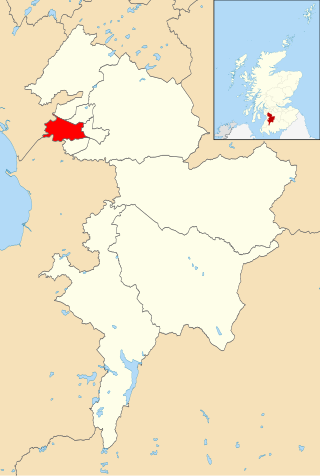
Kilmarnock West and Crosshouse is one of the nine electoral wards of East Ayrshire Council. Created in 2007, the ward elects four councillors using the single transferable vote electoral system and covers an area with a population of 17,739 people.


















